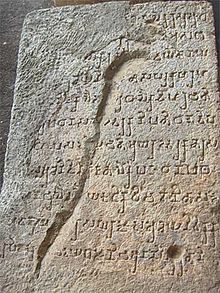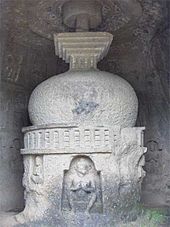The Kanheri Caves are a group of rock-cut monuments, located north of Borivali on the western outskirts of Mumbai, India, deep within the green forests of the Sanjay Gandhi National Park. It is 6 km from the National Park Main Gate & 7 km from Borivali Station. Tourists can go in after 7.30 a.m. Kanheri Caves are signs of Buddhist influence on art and culture in India. Kanheri comes from the Sanskrit word Krishnagiri generally meaning black in colour. They were chiseled out of a massive basaltic rock outcropping.
Description

Rock cut stair leading to Kanheri
These caves date from 1st century BCE to 9th century CE The earliest are 109 tiny rock-cut cells, carved into the side of a hill. Unlike the elegant splendor of Elephanta Caves nearby, these are spartan and unadorned. Each cave has a stone plinth for a bed. A congregation hall with huge stone pillars contains the stupa, a Buddhist shrine. Farther up the hill are the remains of an ancient water system, canals and cisterns that collected and channeled the rainwater into huge tanks.[3] Once the caves became permanent monasteries, they began to be carved out of the rock with intricate reliefs of Buddha and the Bodhisattvas carved into the walls. Kanheri had become an important Buddhist settlement on the Konkan coast by the 3rd century A.D.
Most of the caves are the Buddhist viharas meant for living, study, and meditation. The larger caves were chaityas, or halls for congregational worship, are lined with intricately carved Buddhist sculptures, reliefs and pillars, and contain rock-cut stupas for congregational worship. The Avalokiteshwara is the most distinctive figure. The large number of viharas obviously prove a well-organized existence of Buddhist monks' establishment, which was also connected with many trade centers such as the ports of Sopara, Kalyan, Nasik, Paithan and Ujjain. Kanheri was a University center by the time the area was under the rule of the Maurayan and Kushan empires. In the late 10th century, the Buddhist teacher Atisha (980-1054) came to the Krishnagiri Vihara to study Buddhist meditation under Rahulagupta.
Inscriptions at Kanheri

A Brāhmī stone inscription at Kanheri
Nearly 51 legible inscriptions and 26 epigraphs are found at Kanheri, which include the inscriptions in Brahmi, Devanagari and 3 Pahlavi epigraphs found in Cave 90. One of the significant inscriptions mentions about the marriage of Satavahana ruler Vashishtiputra Satakarni with the daughter of Rudradaman I.
How to get there
Kanheri caves is located deep inside the Sanjay Gandhi National Park which is in Borivali East. Once you get there, you need to pay a certain entry fee at the gate (Once at entry of sanjay gandhi national park and another at the entrance of kanheri caves). The caves are quite a distance away from the entrance, about 5 kilometres (3 mi). Transport by bus to the caves is available every hour.
Around the caves
Kanheri caves offer picnickers a good getaway, especially during the rainy season. The hilly terrain of the caves creates several large and small waterfalls. The road from the entry point of Sanjay Gandhi National Park to Kanheri caves is intercepted at several locations by small rivulets where families can enjoy a lazy weekend get-together.

Kanheri Caves served as a centre of Buddhism in Western India during ancient times









